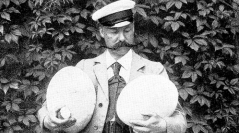

 Anthropozoologica
54 (12) - Pages 111-121
Anthropozoologica
54 (12) - Pages 111-121The huge eggs of the giant extinct bird Aepyornis, from Madagascar, attracted much attention when they were first described by Isidore Geoffroy Saint-Hilaire (1851). However, before 1900, only one illustration of such an egg was published in a scientific paper, by Rowley (1878). By contrast, illustrations of Aepyornis eggs appeared in various other types of publications, notably popular magazines, where they illustrated short items about the giant bird. The first one was published in 1851 in Le Magasin pittoresque, only a few months after Geoffroy Saint-Hilaire’s original description. Similarly, in 1887 the popular science magazine Scientific American published a drawing of an Aepyornis egg. An engraving of an Aepyornis egg was published by Ward (1866) in a catalogue advertising the casts of fossils he was selling. Yule (1871) used a lithograph of an Aepyornis egg as a frontispiece for his translation of Marco Polo’s book of travels, in the belief that the eggs of this giant bird had been the source of the legend of the roc bird mentioned by Polo. In 1885, in a popular book on eggs in plants and animals, Guillaume Capus published an engraving of an Aepyornis egg to illustrate the size range of bird eggs. These early illustrations are reproduced here. They testify to the appeal these huge eggs had for the general public, while scientists working on Aepyornis apparently did not find them sufficiently informative to warrant illustrations.
Aepyornis, eggs, illustrations, popular science.